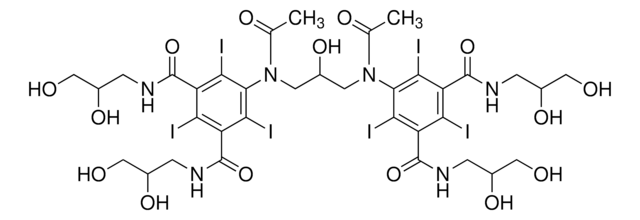T2569
Trizma® hydrochloride solution
pH 7.8, BioPerformance Certified, 1 M, suitable for cell culture
Synonym(s):
Tris hydrochloride solution
Sign Into View Organizational & Contract Pricing
All Photos(1)
About This Item
UNSPSC Code:
12161700
NACRES:
NA.25
Recommended Products
grade
BioPerformance Certified
Molecular Biology
for molecular biology
Quality Level
form
solution
concentration
1 M
technique(s)
cell culture | mammalian: suitable
impurities
DNase, RNase, Protease, none detected
bioburden, tested
endotoxin, tested
≤5 ppm Heavy metals (as Pb)
pH
7.8
useful pH range
7.0-9.0
absorption
≤0.05 at 290 at 40%
Looking for similar products? Visit Product Comparison Guide
General description
A series of Pre-mixed solutions of TRIZMA Base and TRIZMA HCl to provide commonly used pH values for Tris buffers. No mixing or pH adjustment necessary. Guaranteed accuracy ± 0.1 pH units.
Tris(hydroxymethyl)aminomethane (Tris) is a routine buffer in biological sciences. The pH buffering range is between 7.0 -9.0. It displays negligible binding towards metal in solutions. Tris is used majorly in combination with ethylenediaminetetraacetic acid (EDTA), especially for electrophoretic studies. Its low ionic mobility finds usage in capillary electrochromatography as well.
Application
Trizma® hydrochloride solution has been used:
- as a component of lysis buffer for lysing human embryonic kidney (HEK) 293 cells
- in the 10X digoxigenin (DIG) deoxynucleoside triphosphate (dNTP) nick translation labeling buffer and in tris EDTA and sodium chloride (TEN) buffer
- in the preparation of tris, acetate, ethylenediaminetetraacetic acid (EDTA) (1x TAE) buffer and as a component of 10X gel loading dye
Legal Information
Trizma is a registered trademark of Merck KGaA, Darmstadt, Germany
Storage Class Code
10 - Combustible liquids
WGK
WGK 2
Flash Point(F)
Not applicable
Flash Point(C)
Not applicable
Personal Protective Equipment
dust mask type N95 (US), Eyeshields, Gloves
Choose from one of the most recent versions:
Already Own This Product?
Find documentation for the products that you have recently purchased in the Document Library.
Customers Also Viewed
Stuart W Tompson et al.
Bio-protocol, 7(10) (2017-08-02)
There are several in silico programs that endeavor to predict the functional impact of an individual's sequence variation at splice donor/acceptor sites, but experimental confirmation is problematic without a source of RNA from the individual that carries the variant. With
Our team of scientists has experience in all areas of research including Life Science, Material Science, Chemical Synthesis, Chromatography, Analytical and many others.
Contact Technical Service








